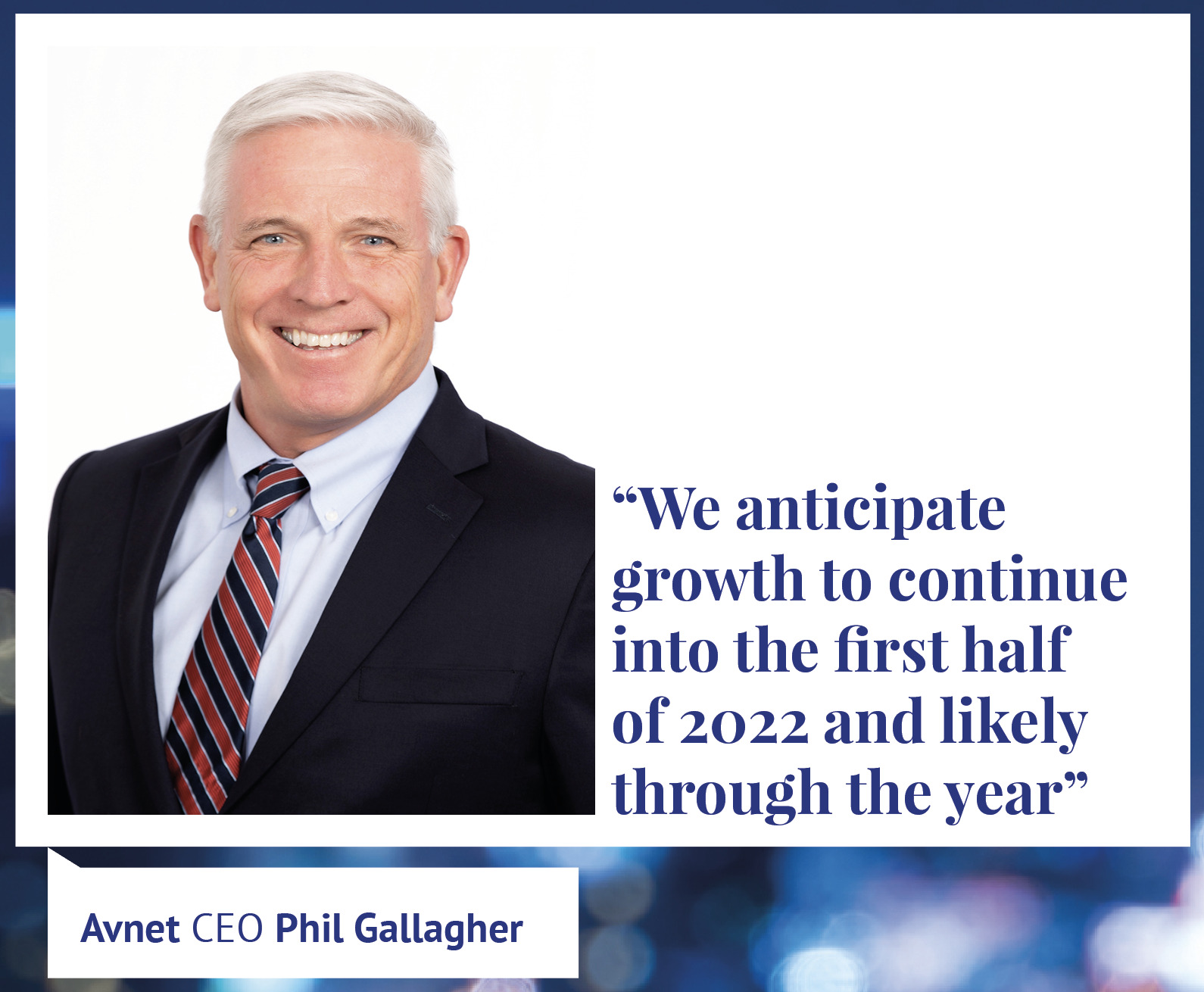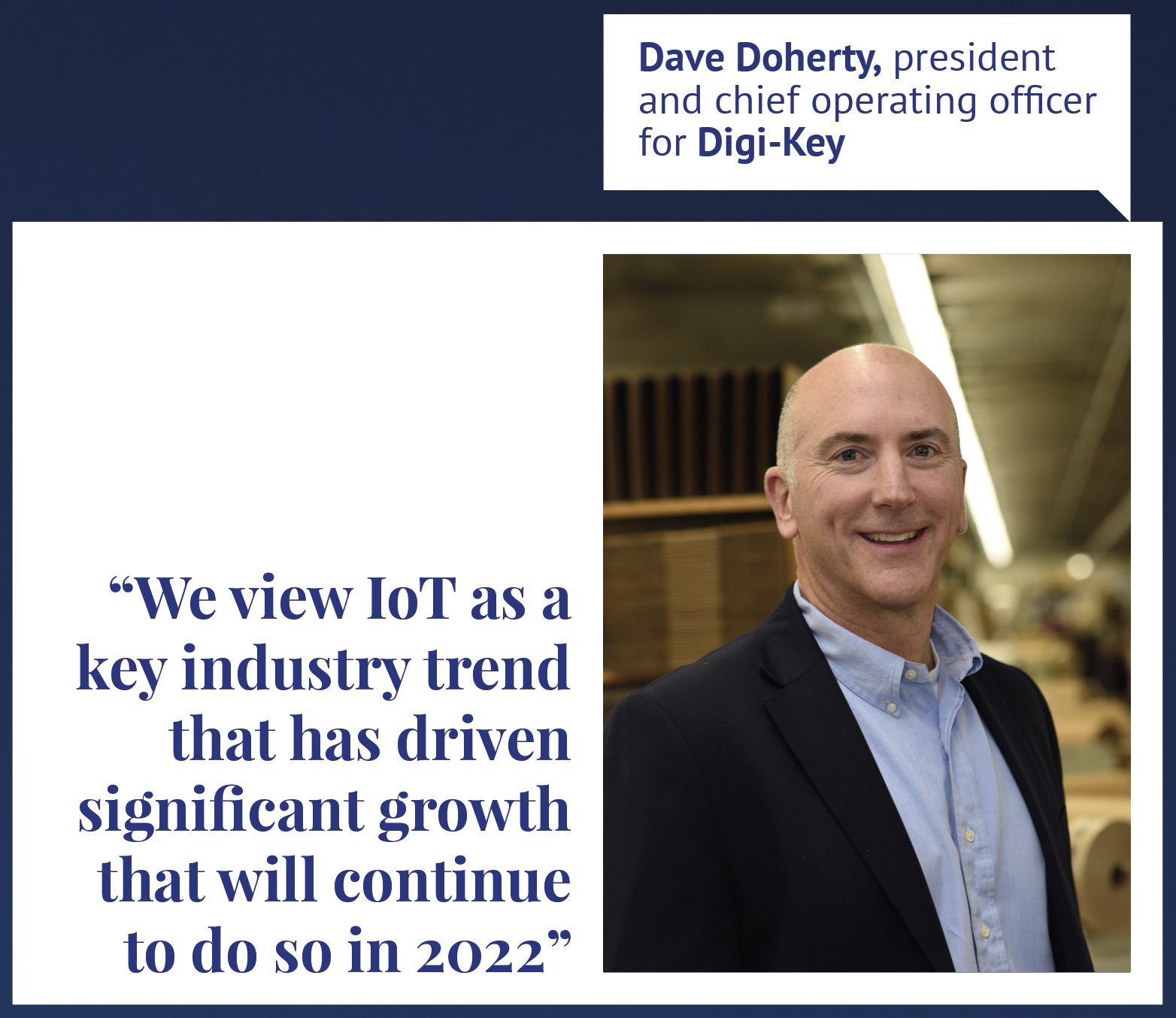 However, while component demand won’t be as strong as 2021, distributors say high single-digit to double-digit growth is possible.
However, while component demand won’t be as strong as 2021, distributors say high single-digit to double-digit growth is possible.
Some distributors reported more than 40 per cent sales growth in North America in 2021 because of surging component demand, higher prices and double-ordering of some parts by buyers fearful that their companies production lines would shut down because of a lack of components.
Distributors expect sales growth will continue in 2022 but acknowledge that growth will not be as robust as last year. Some predict mid-to-high single-digit growth, while others say double-digit growth is possible because durable demand and tighter-than-normal supply conditions will continue in 2022.
The good news for buyers who purchase parts through distributors is that while it will not be a buyer’s market, supply conditions will likely improve as more capacity comes online and demand weakens especially in the second half of the year. However, some distributors say tight supply will last through most of 2022 and may not loosen until 2023.
Avnet CEO Phil Gallagher expects component demand to remain strong in 2022. “We anticipate growth to continue into the first half of 2022 and likely through the year,” he said. “We expect both industrial and consumer segments to continue to drive robust demand, especially as the automotive and aerospace markets recover.”
Gallagher added while it is difficult to forecast how long strong component demand will continue, “most in the market see this strength continuing throughout 2022” and some are projecting that it’ll continue into 2023. Robust demand may not level off until 2024.
Double-digit growth forecast
Mark Burr-Lonnon, senior vice president global service and sales for Mouser Electronics, said the high-service distributor is budgeting for 15 per cent sales growth in North America in 2022. Mouser’s sales would likely end up growing 46 per cent in 2021, Burr-Lonnon said in late November. “There’s a chance we could do more than 15 per cent in 2021,” he said.
One reason is tight component supply will continue to at least the second quarter of 2022, he said. In the second half, the capacity that some of the “manufacturers are bringing on board will have more of an impact” and the market will start to change, he said. However, semiconductor manufacturers say they are already sold out of the capacity that they have, according to Burr-Lonnon. That means supply could remain tight and prices could be stable or increase.
Another distributor that posted strong sales growth in 2021 was Digi-Key. Its North American sales grew 55 per cent, while its global sales rose 65 per cent, according to Dave Doherty, president and chief operating officer. However, sales growth in 2022 may cool off to the 5-8 per cent range, said Doherty. “I believe orders will start to return to more realistic levels in 2022 as customers find more breathing room,” Doherty said.
While distributors’ sales may not grow as strongly in 2022 as they did last year, some distributors are expecting higher-than-normal growth rates because of strong demand from traditional customer segments such as industrial, defense and aerospace, transportation, and medical. In addition, there is growing demand for semiconductors and other components from not-so-traditional segments such as the agriculture, dairy, and beverage industries, among others because of the need for sensing and connectivity.
“For example, in the dairy industry, companies are using semiconductors to help track livestock,” said Gallagher. “In the beer distribution industry, they are tracking use and consumption on taps.”
He noted that more electronics are being used in agricultural equipment. “More produce than you might expect goes bad before it gets to the market. Companies are using sensors to control temperature, measure ethylene output, etc.,” said Gallagher. More sensors and other chips are also being used in water treatment applications.
 Component demand grows in industrial
Component demand grows in industrial
In more traditional segments such as industrial there are subsegments that are using more electronics. “Industrial is one of our largest segments and is very diverse,” said Gallagher. “There’s explosive growth in power tools that are more portable and in smaller form factors,” he said. “Even in those traditional segments, creating smaller and more energy efficient products is the priority.” Such products and capabilities require more chips and other components.
“We continue to see the need for sensing and connectivity across many applications,” said Gallagher. Industrial IoT such as factory automation is an area of opportunity, he said.
Another key segment is automotive. “Automotive is consistently evolving,” said Gallagher. It is also unique in that the demand for components in that industry is rising regardless of the pandemic due to increased consumer demand for electric vehicles and other advanced systems, he said.
“There are more components in an automobile than ever before for driving systems, computer systems, LiDAR, etc.,” he said. He added that commercial aerospace is experiencing spikes in demand that parallel the automotive industry due to demand for infotainment, energy efficiency and small form factors.
Distributors say while demand will remain strong in 2022, macro trends such as 5G, Internet of things (IoT), artificial intelligence and electric vehicles will result in strong component demand for years. Doherty said wireless connectivity, industrial automation and electrification of vehicles will help drive innovation in North America beyond 2022.
“We view IoT as a key industry trend that has driven significant growth that will continue to do so in 2022,” he said. Demand from nearly every industry vertical continues to drive significant interest and investment in IoT development and implementation, according to Doherty. He noted over the last year, there was a surge in new product introductions in every industry from automotive to medical, industrial automation to consumer devices and everything in between, driving business across the board.
5G, IoT, AI to drive growth
The growth rates for “5G, IoT, AI, and electric vehicles are all up into the right,” said Burr-Lonnon. Such technologies will continue to result in more products and applications that will need electronic components. Burr-Lonnon said while 5G has been talked about for years, it is still in its infancy and will grow over the next several years. “It is still nowhere near where it is going to be,” he said. The same is true with IoT and artificial intelligence.
Once those trends fully develop, it will result in more components because of the need for sensing and conductivity in equipment used by those segments.
Because of continuing strong demand, supply conditions will likely remain tight in the first half of 2022 and may continue longer. “All indications are supply conditions will be “tough for the buying community all the way through 2022,” said Burr-Lonnon . “If buyers get relief next year, it could be in the September timeframe.”
Doherty said he was “hopeful” that in 2022 “we will see an uptick in supply and trust that our partners are doing everything in their power to ensure they can meet demand.” Digi-Key works closely with its suppliers to ensure the availability of inventory “throughout this high level of demand,” he said.
Michael Long, chairman, president and CEO of Arrow Electronics, said market intelligence makes it “increasingly clear that supply will remain short of demand through the better part of 2022.” He noted severe supply chain bottlenecks have increased, “leading to widely reported production slowdowns in certain industries.”
At the same time there has been “robust demand from sectors such as transportation, industrial, communications, computing and data networking”, he said.
Buyers will likely face higher prices. “There is no more year-over-year cost reduction on parts like there used to be,” said Long. He noted that costs for raw materials, transportation, handling and labor are up. “These costs are real. These costs are permanent and these costs will be charged for.”
